According to the WHO, every second person on the planet is infected with helminths every year. Many people think that parasitic worms are not very harmful to health. However, not everything is so simple: Helminths can infect important internal organs: heart, lungs, brain.
Helminths - who are they?
Helminths are parasitic worms that can choose the body of a person, animal, or plant to host. There are three classes of helminths in total:
- Tapeworms.This class includes about 3, 5 thousand types of helminths. The length of the parasitic worms varies from a few mm to 10-15 meters;
- Leeches.Parasites got their name due to the presence of suction cups that help them obtain nutrients. The human body can infect about 4 dozen species of leeches. As a rule, the length of the worms does not exceed 5 cm;
- round worms.This class of helminths has more than 24, 000 species. Roundworms are spindle-shaped. Usually their length is no more than 0. 5 meters.
You can get infected with helminths in a number of ways. Most often, however, parasitic invasion occurs for the following reasons:
- Bad hand hygiene.
- Unwashed vegetables, fruits; Uncooked or undercooked meat, fish - the use of such products increases the risk of parasitic infestation many times over.
- Keep food open outside of the refrigerator. Insects can transfer helminth eggs to food that is stored without packaging.
- Contact with pets.

The main symptoms of the presence of parasites in the body:
- Nausea, vomiting, diarrhea;
- Weight loss;
- allergic rashes;
- Flatulence;
- Itching in the anus;
- Teeth grind in a dream.
What worms are most common in Russia? Consider the most common types of parasitic worms and the diseases they cause.
Tapeworms
The body of the tapeworm is made up of elements, the total number of which ranges from 3 to 5000. The main element of fixation of the helminth is the head, additional are suction cups and hooks.
The most common causes of tapeworms are:
- Diphyllobothriasis;
- Teniarin tubes;
- Teniasis.

Diphyllobothriasis
The causative agent of the disease is a broad tapeworm that affects the human intestines. Worm eggs develop in fresh water. The scheme of the tapeworm entering the human body is as follows:
- The worm's eggs are swallowed by crustaceans that live in the reservoir.
- Infected crustaceans are eaten by fish.
- A person becomes infected with a parasite by eating fish that has undergone inadequate heat treatment.
The symptoms of the disease develop 1, 5 months after infection. The main sign of pathology is the presence in the feces of whitish fragments of helminths.
The tapeworm attaches itself to the intestinal lining and absorbs a large amount of vitamin B12. Because of this, people with diphyllobothriasis often develop anemia. In addition, the tapeworm can cause an increase in liver, spleen, and intestinal obstruction.
Teniarinhoz
The causative agent of the disease is the beef tapeworm, which lives mainly in the human small intestine. During its development cycle, the helminth replaces two hosts: the intermediate product is livestock, the main product is humans. Beef tapeworms can live in the body, reproduce and damage health for 20 years.
Typically, people develop teniarin tubes after eating undercooked or undercooked beef.
The disease often proceeds without pronounced symptoms and is detected accidentally when a person sees helminths in the feces. In some people, in addition to the main signs of helminth infection, pain syndrome may appear on the right side of the anterior abdominal wall.
Adult helminths can penetrate the appendix, the pancreatic duct and the biliary tract and cause acute inflammatory processes in them. Intestinal obstruction can develop with multiple parasitic infections.
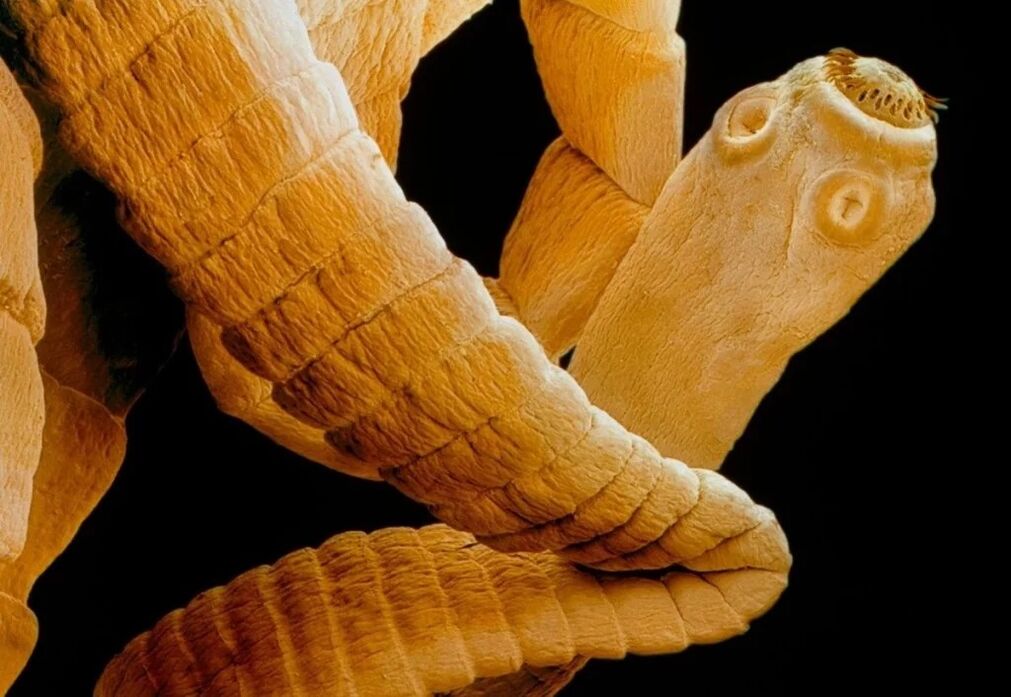
Teniosis
The causative agent of the disease is the pork tapeworm, which initially affects the human small intestine. Human beings are infected by eating raw or improperly cooked pork.
The parasite can invade various organs and tissues and cause pain in the abdomen, back, and limbs. The pathology is most favorable when the worm is localized in the subcutaneous fat and skeletal muscle tissue. When worms invade the eye muscles, they cause a decrease in visual acuity, lacrimation, and photophobia. The defeat of the pork chain of the brain can be fatal.
Suction cups
Flukes are leaf-shaped and have high reproductive capabilities in different periods of the life cycle. The reproduction of worms is possible not only sexually with fertilization, but also without it. In addition to suction cups, worms have many hooks and spikes, which means that they reliably adhere to the mucous membranes of the organs.
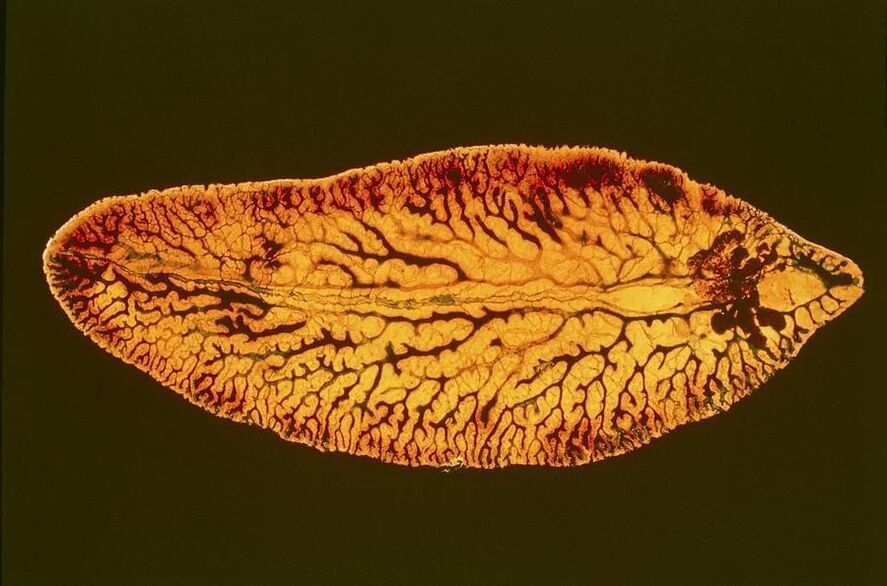
Common pathologies caused by leeches:
- Fascioliasis;
- Opisthorchiasis;
- Paragonimiasis.
Fascioliasis
Fascioliasis occurs when the liver or gallbladder is damaged by the liver fluke. Basically, infection occurs when eating vegetables for which water from open reservoirs has been used.
In addition to the usual signs of a parasite infection, a person may experience asthma attacks that are accompanied by shortness of breath, facial flushing, dilated pupils, and tachycardia. When an adult has caused a blockage in the biliary tract, obstructive jaundice develops. Signs of pathology:
- Cramping pain in the right hypochondrium;
- Yellowing of the skin;
- Fever;
- colorless feces.
Opisthorchiasis
The causative agent of the disease is a cat accident. The name of the parasite comes from the fact that, in addition to humans, it often infects cats and other mammals that eat fish.
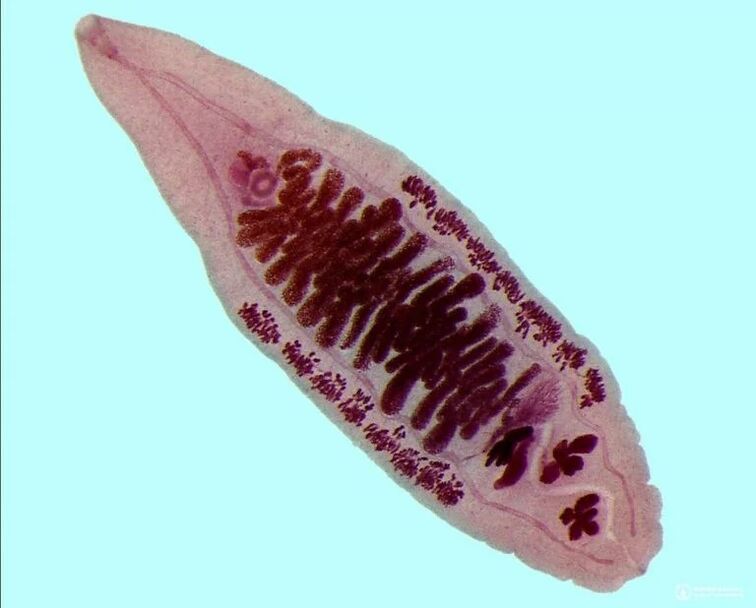
As a rule, the cat leech attacks the liver and pancreas and causes inflammation in the organs. Symptoms vary and depend on the number of parasites. The patient can experience:
- Symptoms of intoxication;
- Fever;
- Hives;
- itchy skin;
- Pain in muscles, joints, right hypochondrium.
In some cases, helminths cause an increase in lymph nodes, the development of jaundice. The chronic form of the pathology often leads to hepatitis, cirrhosis of the liver.
Paragonimiasis
The disease is due to a lung accident that enters the human body with infected crustaceans.
First the parasite enters the human intestine, then the abdominal cavity. The end point of his journey is lung tissue. In addition, the worm can penetrate the brain and affect the central nervous system.
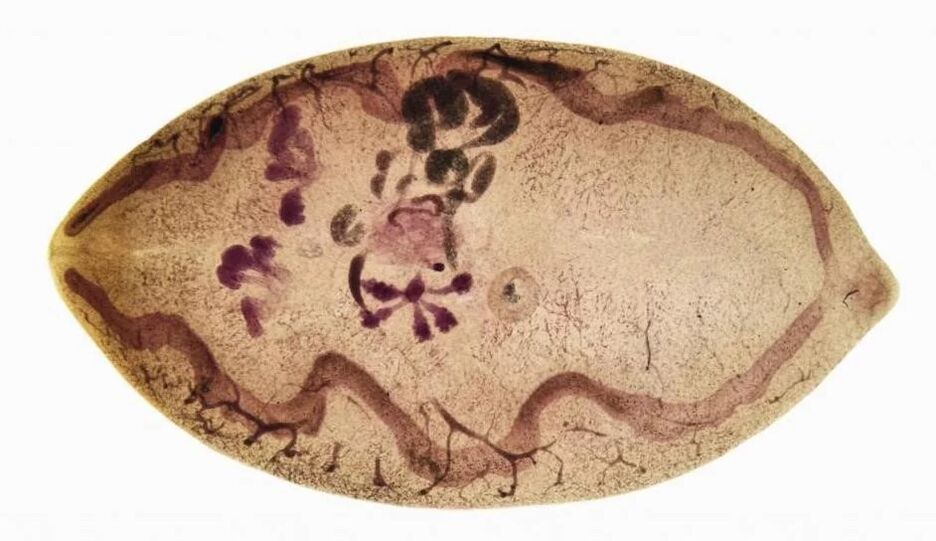
Specific signs of parasitic invasion of the lungs:
- Chest pain;
- Cough with phlegm that may contain pus and blood;
- Fever.
In some cases, helminths cause a violation of the function of ventilation of the lungs and gas exchange during breathing.
Round worms
Due to their structure, roundworms (nematodes) can survive even under extreme conditions. Your body is covered with a three-layer musculocutaneous sack that reliably protects parasites from external influences.
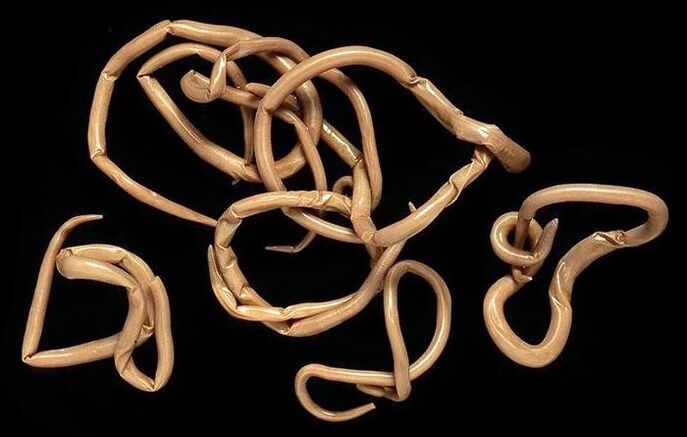
Common diseases caused by nematodes:
- Ascariasis;
- Enterobiasis;
- Trichinosis.
Ascariasis
The development of the disease provokes Ascaris, which are initially fixed in the small intestine. The average length of adults is 40 cm. The larvae of the parasite can enter the human digestive system with unwashed vegetables and fruits, as well as contaminated water. Badly washed hands before eating are also a common cause of ascariasis.
During the penetration of the larvae into the human body, a subfebrile temperature, allergic rashes and a cough with the release of clear sputum can be observed. Signs of the intestinal stage of ascariasis (diarrhea, abdominal pain) are observed only in the presence of several parasites. Life in a worm's gut is usually asymptomatic.
Complications with multiple parasitic infestations:
- Obstruction of the bile duct;
- purulent inflammatory processes in the gallbladder, liver;
- Inflammation of the appendix;
- Intestinal obstruction.
Enterobiasis
The provocateurs of the disease are pinworms - small worms up to 1 cm in length. Helminths enter the human digestive system like roundworms.
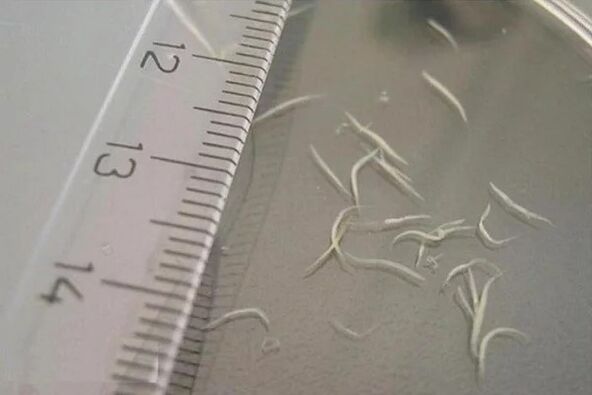
Currently, enterobiasis is the most common parasitic pathology in the world. Basically, the disease is diagnosed in children under 10 years of age.
As in previous cases, the symptoms only occur with multiple parasitic infections. Children often have diarrhea, mucus in the stool, difficult and painful digestion, itching in the anus, and nausea. If the disease is severe, limb cramps can occur. In addition, pinworms can invade the genitals and cause acute inflammation there.
Trichinosis
This disease provokes Trichinella - one of the smallest parasitic worms. The length of the parasite rarely exceeds 4 mm. In the larval stage, worms can infect skeletal muscles. The exception is the myocardium - the muscle tissue of the heart. Adults parasitize the small intestine.
Typically, infection occurs in humans when eating half-baked pork. At the same time, for the development of the disease, it is enough to consume only 30 g of meat affected by parasites.
The pathology is manifested in the standard symptoms of a parasitic invasion. At an advanced stage, swelling of the eyelids, face, arms, and legs, lower back pain, and muscles of mastication may occur. Possible complications are complete or partial loss of mobility, respiratory paralysis.
How do I avoid a helminth infestation?
To reduce your risk of contracting parasitic worms, it is important to follow these guidelines:
- Wash your hands thoroughly before eating, after visiting the street in public places.
- Observe the right technology for cooking meat and fish. The heat treatment of meat and fish products should take at least 20 minutes.
- Do not eat dried or dried fish.
- Perform deworming of pets.
- Get tested regularly, even if you don't have any pathological signs. The most common diagnostic methods are the macroscopic and microscopic examination of feces. The first method allows you to identify adults, the second - eggs and larvae of worms.
























